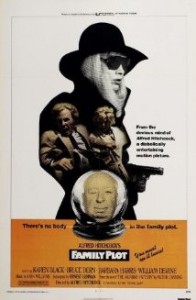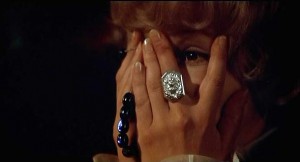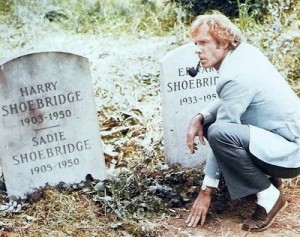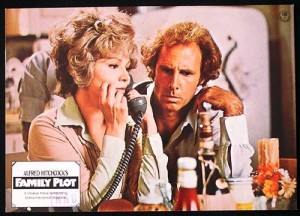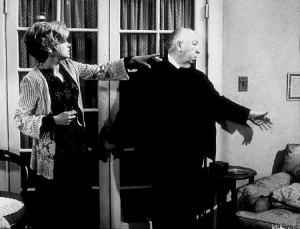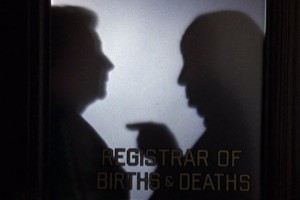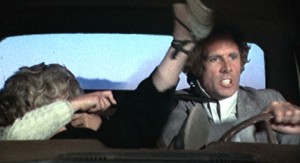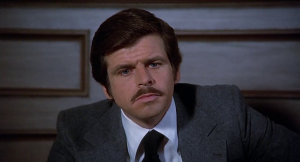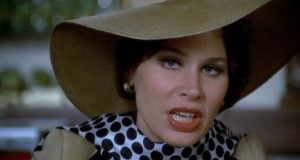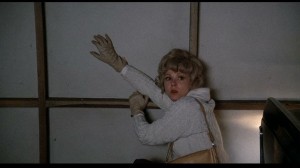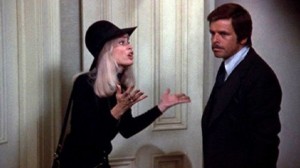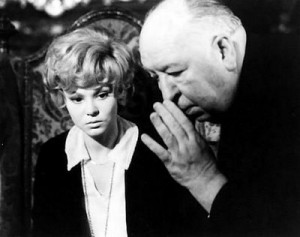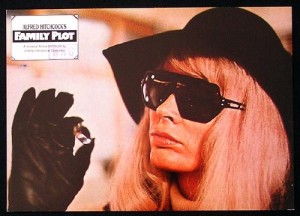Family Plot **** (1976, Karen Black, Bruce Dern, Barbara Harris, William Devane) – Classic Movie Review 464
Alfred Hitchcock’s 53rd and final movie Family Plot, made in 1976 when he was 76, is a deliciously playful, witty farewell. He called it ‘a melodrama treated with a bit of levity and sophistication. I want the feeling of the famous director Ernst Lubitsch making a mystery thriller.’
His sparkling, deftly light-hearted black comedy suspense thriller stars Barbara Harris as Madame Blanche Tyler, a con artist operating as a phoney spiritualist. She becomes involved in a plot with her taxi driver/ private investigator boyfriend George Lumley (Bruce Dern) to extort money out of tormented old millionairess Julia Rainbird (Cathleen Nesbitt). At a séance, Madame Blanche finds out that the old girl forced her recently-deceased sister and single mother Harriet to deliver her baby boy for adoption to avoid a family scandal.
So guilt-ridden Julia promises $10,000 to Blanche if she will use her (fake) spiritualist powers and find Julia’s missing nephew and heir to her fortune. Blanche then asks her boyfriend George to see if he can find the heir.
George discovers the adopted baby boy was renamed Edward Shoebridge but apparently died young. However, after finding Joseph Maloney (Ed Lauter), who paid for Edward’s tombstone years after he supposedly died, George comes to think the grave is empty.
Along the way, complications arise in the dark, dangerous and dodgy forms of the greedy jeweller and collector Arthur Adamson (William Devane) and his live-in girlfriend Fran (Karen Black). They kidnap rich folk, seizing and confining the millionaires and dignitaries in a secure room in their cellar, and return them in exchange for valuable gem stone ransoms to increase Arthur’s collection of diamonds.
When Blanche and George encounter the couple, Arthur and Fran are currently busy involved in a kidnap/ murder plot. Then, after George concludes that Arthur Adamson must Julia’s heir he is looking for, ie Edward Shoebridge, Blanche gets into deep trouble with the pair of creepy serial kidnappers. Black appropriately plays the villainous woman in black, and very menacing she is too in her black hat, black dress, large black sunglasses and long blonde wig.
Happily, Family Plot reunites Hitchcock with Ernest Lehman, his writer on North by Northwest, and they have pretty much struck gold twice, even if Family Plot doesn’t quite have the allure or reputation of North by Northwest. In any case the screenplay is a model of lightweight, cynical wit.
Based on Victor Canning’s 1972 novel The Rainbird Pattern, this mystery movie is extremely sprightly and just lots of fun. Although, despite the spoofy, campy tone on the surface, underneath it often digs deeper and moves into the darker territory of the novel.
The Master of Suspense’s sense of wit, style and fun, his control of pacing, his visual imagination and his special flair for thrillers – the Hitchcock touch – stayed with him to the end. Family Plot remains true to his usual obsessions, though they are many and various, and to the themes of his Thirties and Forties movies. But he has found a way to reinvent them to make them still seem ‘modern’ and involving.
Hitchcock took a chance on not employing big stars and instead has cast his film ideally. And, returning the favour, his performers play their roles to the max for him. All four actors are just right and give vivacious, magnetic performances. Certainly his quintessentially Seventies actors are a huge asset to this film.
Bruce Dern is no Cary Grant and Barbara Harris no Ingrid Bergman. They bring on the scruffy, cynical Seventies feel of modernity and spread it through the film. All of them are working at the top of their game. Dern was a Hitchcock favourite, having previously worked with him on episodes of TV’s Alfred Hitchcock Presents and had a small role in Marnie.
Of course Hitch did not need stars just good actors. He was the star. He went out with a hit. It cost $4.5 million and took $13.2 million.
Other assets are the twinkingly sparky score by John Williams, his only one for Hitchcock, and the Technicolor work of cinematographer Leonard J South, who proved an ideal interpreter of the director’s visual style.
The movie’s cheeky final shot is of Harris winking at the audience. It proved a perfect way for Hitchcock to say goodbye. Although, even so, Hitchcock did not intend it as his last picture, and at the time of his death on 29 he was still working on another movie, an adaptation of the spy thriller The Short Night by Ronald Kirkbride.
Hitchcock’s rather eerie final cameo appearance is only in silhouette, 45 minutes into the film seen through the glass door of the vital statistics office at the registrar of births and deaths.
Devane to Ed Lauter (in the role of Maloney): ‘Isn’t it touching how a perfect murder has kept our friendship alive all these years?’
The restaurant in the film was built on the Universal Studios back lot and could be seen on studio tours at the time.
Karen Black summed it up beautifully: ‘Hitchcock’s a great man. He has ebullience of spirit, lightness of heart, charm.’
The caste are Bruce Dern as George Lumley, Barbara Harris as Blanche Tyler, William Devane as Arthur Adamson/ Edward Shoebridge, Karen Black as Fran, Cathleen Nesbitt as Julia Rainbird, Ed Lauter as Joseph P Maloney Katherine Helmond as Mrs Maloney, Nicholas Colasanto as Victor Constantine, Edith Atwater as Mrs Clay, William Prince as Bishop Wood, Marge Redmond as Vera Hannagan, Warren J Kemmerling, John Lehne, Charles Tyner, Alexander Lockwood, Martin West, Louise Lorimer, Kate Murtaugh, and Clint Young.
Karen Black died on A, aged 74.
Ed Lauter died on , also aged 74.
Barbara Harris, star actress in A Thousand Clowns, Plaza Suite, Nashville, Freaky Friday and Family Plot, died at 83 on 21 . Her last film was Grosse Pointe Blank in 1997.
© Derek Winnert 2013 Classic Movie Review 464
Check out more reviews on http://derekwinnert.com

